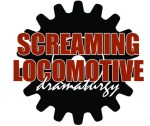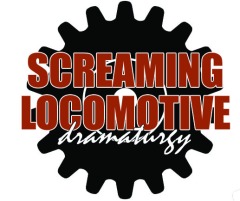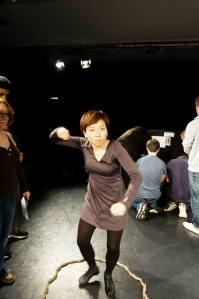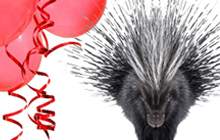 A Season at East 15
A Season at East 15
It’s been a busy couple month since the last missive.
I’ve wrapped up my first year in the MFA in Theatre Direction International at East 15. It’s been a great year that has finished on a high note The Physical Theatre module. Lead by Robin Guiver (Warhorse) and Heriberto Montalban from LISPA was an intensive in Lecoq, Physical and Movement Theatre Performance (including Laban and Viewpoints), Mask, Puppetry, Choral Work and Devising. Master classes were led by some of the UK’s exciting independent theatre devisers including Will Pinchin and Dorie Kinnear from Grafted Cede (The Odyssey), Allel Nedjari from Gecko Theatre (The Arab and the Jew) and Jennifer Pearcy-Edwards, Infectious Theatre.
This was an opportunity to not only revisit my past physical theatre training under Moni Yakim (Circle in the Square, Head of Movement at Julliard) with fresh eyes, but the opportunity to dive into new ideas and further the physical practice in my work. This was a rich and wonderful module and a great way to end the year. My final project included a biobox (Thanks you Theatre Replacement!), physical audience interaction and open space technology in performance in a living gallery.
After four years on the road exploring the diverse practices in the Canadian landscape, East 15 has been a the chance to put it all into perspective while using these experiences as a launch pad to further develop past practices and explore new possibilities in the work. The season’s modules included Shakespeare, Adaptation, Artistic Director and Physical Theatre with each providing new insight, new understandings and opening to push my practice to places it hasn’t gone before.
 After a season at East 15, I can only say it was the right thing to do. It’s hard to top things like the knowledge gained simply by standing on the Globe Theatre (Ohh that’s what he’s talking about!), the opportunity to see large theatre in a variety of forms from The Tricycle Theatre to The National and The Young Vic or the innovative touring national and international companies in action. Or master classes with artists Artists like Lucy Bailey (English National Opera), Michael Pennington (Royal Shakespeare Company), Mike Alfreds (Shared Experience) and Robin Soans (Talking to Terrorists).
After a season at East 15, I can only say it was the right thing to do. It’s hard to top things like the knowledge gained simply by standing on the Globe Theatre (Ohh that’s what he’s talking about!), the opportunity to see large theatre in a variety of forms from The Tricycle Theatre to The National and The Young Vic or the innovative touring national and international companies in action. Or master classes with artists Artists like Lucy Bailey (English National Opera), Michael Pennington (Royal Shakespeare Company), Mike Alfreds (Shared Experience) and Robin Soans (Talking to Terrorists).
The Shakespeare Module was the opportunity to revisit a first love. This included excursions with The Globe Theatre and the Royal Shakespeare Company and an exploration of contemporary and classical British approaches and methods to classical theatre. My final project was exploration combining Neil Freeman’s First Folio work along with Cecil Barry and movement work in a development of Choral creation. In a scene from A Midsummer Night’s Dream, four actors played Oberon in a literal presentation of the King of “Shadows”; splitting apart, speaking in separate voices, overlapping and joining again around Puck.
The Adaptation Module was the opportunity to strengthen both my dramaturgy base and delve deeper into the worlds of adaptation and new play development and creation. The final projects teamed up with the MFA International Actors providing to be a perfect opportunity to tackle multi-lingual and multi-disciplinary work. In a devised piece, I and my actors explored the relationship between direct human communication and texting using viewpoints, clown and a modern dance to a reading of GUAN SUI of The Book of Songs.
 One of the modules unique of East 15 was The Artistic Director Module. Led by Anthony Clark (Hampstead Theatre), this was a very interesting door into the UK theatre ecology. Building on the my own past experience in theatre production and my 2011/2012 Three Company, Three Provinces, Three Mandates AD Mentorship, this was the chance to compare to current Canadian models with its British counterparts. Funding, management, development and governance were discussed extensively along with explorations of both small and large scale production, development models from other nations, marketing, touring and multiple season budgets. The final project was a three year business plan and budget based on one of my favorite venues in Vancouver.
One of the modules unique of East 15 was The Artistic Director Module. Led by Anthony Clark (Hampstead Theatre), this was a very interesting door into the UK theatre ecology. Building on the my own past experience in theatre production and my 2011/2012 Three Company, Three Provinces, Three Mandates AD Mentorship, this was the chance to compare to current Canadian models with its British counterparts. Funding, management, development and governance were discussed extensively along with explorations of both small and large scale production, development models from other nations, marketing, touring and multiple season budgets. The final project was a three year business plan and budget based on one of my favorite venues in Vancouver.
As is true of any artistic undertaking, one of the most exciting and beneficial elements of this MFA is the artists you get to work with. Here, I’ve had the opportunity to collaborate with artists from across the globe, from the UK, Iran, Hong Kong, Romania, Brazil, South Korea, etc. with each bringing unique backgrounds, practices and ideas to the table. It continues to be an eye opening and gratifying adventure.
BoucheWHACKED! Theatre Collective
 Meanwhile back in Vancouver, BoucheWHACKED! Theatre Collective, led by Jessie Award winner France Perras and me, continued our dedication to bring contemporary francophone work in translation to the west coast audience with our second Ta Gueule Staged Reading Series.
Meanwhile back in Vancouver, BoucheWHACKED! Theatre Collective, led by Jessie Award winner France Perras and me, continued our dedication to bring contemporary francophone work in translation to the west coast audience with our second Ta Gueule Staged Reading Series.
Hosted by the rEvolver Festival and The Cultch, BoucheWHACKED! presented another successful series with some of Vancouver’s leading talent.
 The first presentation of the series was Prix Michel-Tremblay and the 2010 Governor General Award winner PORCUPINE (PORC-ÉPIC) by David Paquet and translated by Maurine Labonté. Directed by Rachel Peake, humour, poetry and tragedy combined in Cassandra’s desperate hunt for party guests on her birthday. Featuring Josette Jorge, Jesse Martyn, France Perras, Michael Rinaldi, Stacie Steadman and Jonathan Winsby. We were also thrilled to welcome playwright David Paquet all the way from Montreal for this English Language premiere.
The first presentation of the series was Prix Michel-Tremblay and the 2010 Governor General Award winner PORCUPINE (PORC-ÉPIC) by David Paquet and translated by Maurine Labonté. Directed by Rachel Peake, humour, poetry and tragedy combined in Cassandra’s desperate hunt for party guests on her birthday. Featuring Josette Jorge, Jesse Martyn, France Perras, Michael Rinaldi, Stacie Steadman and Jonathan Winsby. We were also thrilled to welcome playwright David Paquet all the way from Montreal for this English Language premiere.
This was followed by a workshop and reading of local bilingual theatre artist Gilles Poulin-Denis’ Governor General Award nominee REARVIEW. Dramaturged and directed by PTC’s Heidi Taylor and featured David Mott, REARVIEW was an exciting journey down a road without destination into the night and self.
Special Thanks to Ashby House B&B, Le Centre des Auteurs Dramatique, The Electric Company and The Progress Lab, PI Theatre, PTC, Theatre Conspiracy, UpintheAir Theatre, BC Arts Council and all the artists involved.
New Works, Play Development and Translation
Back on the other side of the world, BoucheWHACKED! joined forces with East 15 on workshopping our first “in house” translation translated by yours truly.
 Nous voir nous
Nous voir nous
By Guillaume Corbeil
Translated by Jack Paterson
In a blend of facebook, poetry and in-yer-face theatre, five characters present their lives and relationships through a series of social networking websites. Scene after scene, they shape and reshape their identities, seeking to prove their own uniqueness.
In 2008, Guillaume Corbeil published a collection of stories entitled L’art dela fugue (éditions L’Instant Même); He has been shortlisted for the Governor General’s award and was awarded the Prix Adrienne-Choquette. In September 2009, his first novel, Pleurer comme dans les films, was published by Leméac. He has also written a biography of Director André Brassard. In 2011, he finished training in playwriting at the national theatre school of the Canada. Since, for the scene he written sevral plays including Le Mécanicien, Tu iras la chercher et Nous voir nous, presented by PàP under the title Cinq visages pour Camille Brunelle.
A special thanks to the artist who joined our two workshops: Roman Blomme, Vanessa Buckly, Owen Clark, Ming Hudson, Kate Hunter, Aslam Husain, Courtney Larkin, Lorena de za Parra and Sigmond Varga.
Dramaturgy
 Managing to straddle “the pond” and maintain a dedication to Canadian new works the last month has included dramaturgy for:
Managing to straddle “the pond” and maintain a dedication to Canadian new works the last month has included dramaturgy for:
- Intrusion by emerging Vancouver playwright Veronique West (winner of the Tarragon 20/20 Playwriting Competition – Way to go Vee!)
- Shine: A Burlesque Musical with Book by Sam Dulmage & Cass King and Lyrics and Music by John Woods and Cass King (The Wet Spots).
If you are looking for some dramaturgy at any phase of development, contact me at Paterson_John@hotmail.com.
Filmmaking
 I also recently joined forces with the East 15 MA in Filmmaking. The last few months have also included dramaturgy and the lead role in Eric Chu’s Choices as a man grapples with a choice of money and love.
I also recently joined forces with the East 15 MA in Filmmaking. The last few months have also included dramaturgy and the lead role in Eric Chu’s Choices as a man grapples with a choice of money and love.
And my first foray into screen writing and film direction. I joined director Da Teng in co-writing and co-directing his short film Fly. The story of the friendship between a fatherless boy, a man who doesn’t like kids and a Supermen action figure. A huge thank you to Ted and cast and crew!
Have a great summer and see you at the theatre!
Jack Paterson
Thoughts and Freebies
Click on the links for:
On Shakespeare
On Physical Theatre
Production:
CAEA Co-op Agreement Support Material
On Canadian Theatre
 Managing to straddle “the pond” and maintain a dedication to Canadian new works the last few months has included supportive dramaturgy for:
Managing to straddle “the pond” and maintain a dedication to Canadian new works the last few months has included supportive dramaturgy for:




















